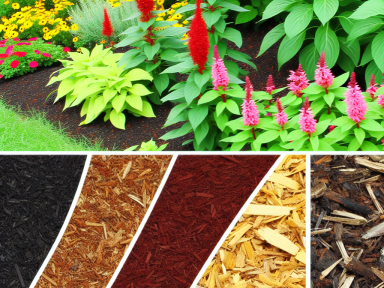Colored mulch can do wonders for your garden, adding both visual appeal and functional benefits. While most gardeners are familiar with the typical brown or black mulch, branching out into colored mulches can bring new life to your outdoor space. Let’s explore some tips and tricks to get the most out of this gardening technique.
Choosing the Right Color
Colored mulches come in various shades, each offering unique aesthetic benefits and practical advantages. Here are a few popular options:
- Red Mulch: Ideal for gardens with vibrant green plants, red mulch creates a striking contrast that can make your foliage stand out. Red mulch is particularly effective in gardens featuring brick or stone pathways.
- Brown Mulch: A more natural look that blends seamlessly with soil, brown mulch offers a subdued elegance. It’s excellent for woodland gardens or areas with a lot of natural elements.
- Black Mulch: Best for modern, minimalist gardens, black mulch provides a sleek, polished look. This color helps retain moisture and heat, making it excellent for vegetable beds.
- Gold Mulch: Perfect for gardens needing a bright, cheerful touch. Gold mulch works well in areas with darker foliage or shaded spots that need a pop of color.
Application Tips
Applying colored mulch requires some forethought to ensure both maximum visual impact and garden health.
Depth Matters
Always apply mulch to a depth of about 2-3 inches. This thickness is optimal for moisture retention and weed suppression without suffocating plant roots.
Preparation
Before spreading mulch, clear the area of weeds and debris. Adding a layer of newspaper or landscape fabric can further prevent weed growth.
Consistency
Maintain a consistent layer throughout your garden to ensure uniformity. This not only looks great but helps in distributing moisture evenly.
Additional Tips
Consider these additional tips for making the most out of your colored mulch:
- Refresh Annually: Colored mulches tend to fade over time. Refresh the color and replenish the mulch each spring to keep your garden looking vibrant.
- Choose Non-Toxic Mulch: Ensure that any colored mulch you choose is made from non-toxic, natural dyes to prevent harm to your plants and soil.
- Combining Colors: Don’t be afraid to mix and match colored mulches in your garden. For example, use black mulch for vegetable beds and red mulch for ornamental flower beds to create distinct and stunning sections.
Benefits Beyond Beauty
Besides improving aesthetics, colored mulch provides several practical benefits:
- Moisture Retention: Mulch helps retain soil moisture by reducing evaporation, essential during hot summer months.
- Weed Suppression: A thick mulch layer prevents weed seeds from germinating by blocking sunlight.
- Temperature Regulation: Mulch insulates the soil, keeping it cooler in the summer and warmer in the winter, creating a more stable environment for root systems.
Implementing these tips will not only enhance the beauty of your garden but also contribute to its health and vitality. Enjoy experimenting with different colors and discover the transformative power of colored mulch in your gardening adventures.




GIPHY App Key not set. Please check settings